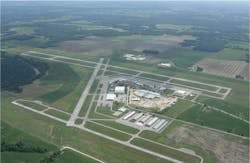The state-of-the-art construction project nearing completion at Southern Illinois University Carbondale will be one of the nation’s leading transportation centers.
The nearly 230,000-square foot Transportation Education Center (TEC), located at the Southern Illinois Airport, will offer enhanced learning and research opportunities for students in the University’s nationally recognized aviation and automotive programs. Officials expect the facility will also create economic development opportunities.
The nearly $63 million project includes $56.7 million from a statewide capital construction plan signed into law in July 2009. The remaining amount includes funds for design fees and Leadership in Energy and Energy Design, or LEED, certification. The facility is now 65 percent complete with a projected July 2012 completion.
The TEC complex includes the approximate 186,000-square foot main education building, a nearly 11,000-square foot aviation test cell, and a nearly 32,000-square foot fleet storage building.
The facility will bring the aviation and automotive programs into one general area. Prior to this, aviation management and flight programs split instruction between facilities at the airport and campus buildings in Carbondale, with aviation technologies classes meeting at the airport. The automotive technology program has the bulk of its classes in World War II-era buildings on the University’s campus in Carterville, about 16 miles from the airport.
The airport will see several benefits and additional opportunities once the TEC is finished, says Gary Shafer, Southern Illinois Airport manager. The facility will help market property both on and off airport grounds. Shafer anticipates approximately 250 acres of development property will be available.
“The most significant will be the place on the aviation map that the center will provide to the airport,” he says. “It’s going to more firmly entrench us as one of the leading aviation training centers in the country.
“The mere presence of these nationally known programs is going to make it easier for the airport and economic development agencies in the area to market our available properties to aviation- and automotive-related industries.”
Another benefit will be the addition of more than 300 people on the airport grounds each day for classes, lectures, and meetings. Five degree programs will be inside the TEC — automotive technology, aviation technologies, aviation flight, aviation management, and the University’s master of public administration in aviation administration concentration.
“That additional population will entrench what we deliver out here, such as food service, and increase revenue opportunities for the airport,” says Shafer.
The TEC includes a nearly 11,000-square-foot aviation test cell that will allow aviation technologies students and faculty to run high-powered turbine and piston engines. The facility, which will feature four separate cells, will have the most advanced instrumentation and equipment available.
For the aviation management and flight programs, a key addition is a 3,250-square foot flight simulation area. The flight simulation area is more than six times larger than the current flight simulation area, and will house a level V Regional Jet Flight Training Device (FTD) along with other new flight simulation equipment.
There will also be new weather and dispatch services, an aviation computer laboratory testing area, and two new air traffic control laboratory spaces. One laboratory will focus on tower air traffic control training, and the second for radar air traffic control training. SIU Carbondale is the only public university in the state to offer an Air Traffic Control minor.
Officials foresee increased enrollment in all of the programs as the TEC begins operation. With program enrollments now among the highest levels, department officials anticipate a five to ten percent rise in enrollment in the three years after the facility is finished, given the availability of supporting resources for equipment and faculty.
The programs are working to obtain significant alumni and industry support for the TEC, especially as it relates to specialized equipment, ongoing operations, and student scholarships.

